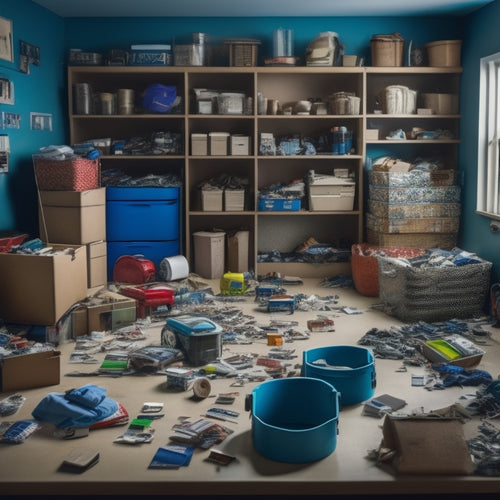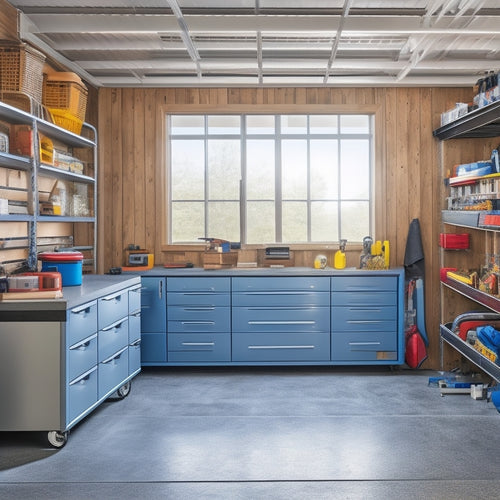
Boosting Art Sales: Winning Strategies Revealed
Share
You're on the verge of revealing the hidden patterns that drive art sales. To boost your sales, you need to understand your customer's preferences and tailor your approach to resonate with their tastes. A winning portfolio showcases your artistic vision, while strategically set prices balance profitability and affordability. Effective booth strategies curate a visually appealing collection, guiding customers' eyes to focal points. But it's genuine connections with potential buyers that ultimately convert browsers into collectors. By mastering these five essential elements, you'll reveal the secrets to selling more art - and it all starts with understanding the intricate dance between art and buyer.
Key Takeaways
• Understand customer preferences to tailor your sales approach, increasing the likelihood of converting browsers to collectors.
• Craft a diverse and visually appealing portfolio that showcases your artistic range and resonates with potential buyers.
• Strategically set prices that balance profitability and affordability, considering buyer psychology, competition, and perceived value.
• Design an engaging booth that guides customers' eyes and encourages them to linger, with a curated collection and focal points.
• Build genuine connections with potential buyers by sharing the story behind each piece and providing personalized recommendations.
Understanding Your Customer
As you step into the art sales arena, understanding your customer becomes essential, since their preferences, behaviors, and connections with you can greatly impact your sales.
You need to grasp what drives their buying decisions and what makes them tick. Identifying customer preferences is important, as it allows you to tailor your approach and showcase pieces that resonate with them.
Effective buyer engagement is also crucial, as it fosters a connection between the customer and your art. By recognizing patterns in customer preferences, you can adapt your strategy to cater to their needs, ultimately leading to increased sales.
Crafting a Winning Portfolio
Your portfolio is a curated representation of your artistic vision, and its strategic composition can make or break your chances of catching a potential buyer's attention. To craft a winning portfolio, you'll want to showcase diversity in your artistic techniques, highlighting your range and versatility.
Here are three key strategies to keep in mind:
-
Explore niche markets and specialized products that set you apart from others and appeal to specific buyer interests.
-
Highlight your artistic range by including a mix of styles, mediums, and subjects to demonstrate your mastery of different techniques.
-
Curate a cohesive visual narrative that tells a story about your artistic vision and style, making it easy for buyers to connect with your work.
Pricing for Maximum Sales
By strategically setting prices that balance profitability with customer affordability, you can maximize sales and attract a loyal client base. To achieve this, you need to understand buyer psychology and competitive pricing.
Consider the perceived value of your art, taking into account factors like materials, time, and expertise. Research your competition to determine a fair market price. Be flexible, and be prepared to negotiate. Offering different price points can cater to various customer budgets, increasing the chances of making a sale.
Consider offering limited-time discounts or promotions to incentivize customers. Ultimately, finding the sweet spot between profitability and affordability will help you drive sales and build a loyal customer base.
Effective Booth Strategies
To create an effective booth strategy, you'll want to carefully curate your art pieces to showcase a visually appealing and cohesive collection that draws customers in and encourages them to linger. A well-planned booth setup can make all the difference in attracting customers and driving sales. Here are three key considerations to keep in mind:
-
Balance and harmony: Guarantee your artwork is arranged in a way that creates a sense of balance and harmony, making it easy on the eyes and inviting to explore.
-
Visual flow: Design your booth to guide customers' eyes through your artwork, creating a natural flow that encourages them to stop and engage with each piece.
-
Focal points: Establish focal points, such as statement pieces or eye-catching displays, to draw customers in and capture their attention.
Engaging With Potential Buyers
As you step into the role of salesperson, you'll find that making a genuine connection with potential buyers is essential to converting browsers into collectors. To do this, focus on building connections by understanding customer preferences and tailoring your approach accordingly.
Share artist storytelling behind each piece, providing personalized recommendations that resonate with their tastes. This personalized touch will help establish trust and foster a sense of ownership, increasing the likelihood of a sale.
Frequently Asked Questions
How Do I Handle Price Negotiations With Confident Customers?
When negotiating prices with confident customers, you'll excel by using sales scripts that acknowledge their savvy, leveraging customer psychology to create a win-win scenario, and being prepared to offer alternatives that still meet their needs.
What Is the Ideal Booth Layout for Maximizing Art Visibility?
You'll want to design an eye-catching booth layout that guides visitors through your art pieces, utilizing flow management to create a natural path that encourages exploration, ultimately increasing visibility and potential sales.
Can I Sell Art Pieces Without Displaying Them in the Booth?
You can sell art pieces without displaying them in the booth by leveraging digital showcases and online galleries, allowing you to showcase a broader portfolio, tap into online markets, and cater to customers who prefer digital browsing.
How Often Should I Restock and Refresh My Art Pieces on Display?
You should restock and refresh your art pieces on display every 2-3 months, incorporating seasonal rotations to keep your art fresh and exciting, and showcasing your artistic evolution to attract repeat customers.
Are There Any Legal Considerations for Selling Art at Local Shows?
When selling art at local shows, you'll need to take into account art insurance to protect your work and investments. Carefully review venue contracts to make sure you understand liability, commission rates, and display requirements, guaranteeing a smooth and successful event.
Related Posts
-

What Size Rolling Storage Bin Do I Need
To determine the ideal size of your rolling storage bin, you'll need to measure your storage space accurately, consid...
-

Benefits of Pegboard Racks in Your Garage
By installing a pegboard rack in your garage, you'll reveal a wealth of benefits that change your workspace into a hi...
-

Top Rolling Tool Box Drawers for Maximum Storage
When it comes to maximizing storage with rolling tool box drawers, you need a solution that combines durability, cust...


